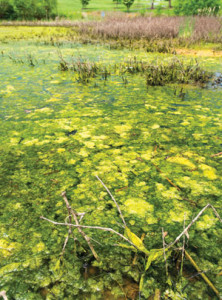Some of the most exciting environmental sensing research in the world is being completed by SMART: the Singapore-MIT Alliance for Research and Technology. The partnership helps Singapore’s government develop research and technology to combat overpopulation and environmental crises. Tawfiq Taher, an MIT research manager within SMART, is using a Kingfisher USV to rise to the challenge.
Singapore’s national crises
Singapore’s population is growing at a rate that can’t be accommodated because the land available is limited. Due to this serious dilemma, the government must survey and monitor areas for potential land-fill with the intention to reconstruct new sites for population growth.
As if over-population wasn’t challenging enough, the country also faces plant overgrowth of algae blooms. The seemingly harmless algae blooms appear suddenly and are known for clogging fish gills, killing coral, and even omitting lethal toxins to the fish, removing a major source of food for the country.
A fleet for environmental change
With these two challenges in focus, Taher’s team is using the Kingfisher USV to research possible solutions for these issues. Thus far, they have developed a robotic sensor networks, control algorithms, novel propulsion, and navigation and sensing tools to safely and efficiently monitor and survey the Singapore coast. The team have been studying Singapore coastal water for more than 7 years, using Kingfisher among their robot fleet; “We are currently looking at a few national challenges focused on Singapore such as monitoring harmful algae bloom and land reclamation,” explains Taher.
The alliance needed a platform that was reliable and able to consistently survey the water at a minimal cost, using a minimal amount of energy. “We decided to obtain a Clearpath Kingfisher because of its compact design, which makes it a great mobile sensor platform,” says Taher. The MIT researcher explained that the advantage of Kingfisher being a mobile platform is that it can respond to unexpected scenarios without prior detail planning. For example, the sudden occurrence of a harmful algae bloom can decimate more than 500 tonnes of fish farms, as it did off of Changi and Lim Chu Kang in February 2015 – when it’s sudden, teams must move quickly to deescalate risk.
Shaping Singapore’s future
These issues are categorized as critical by Singapore’s government, which is why they are fully funding the project with MIT. Information taken from the teams’ studies is shared with Singapore government agencies to impact day-to-day regulations and long-term planning. The lab’s work has also been published in international journals ranging from the International Journal of Field Robotics to the IEEE Journal of Oceanic Engineering.
“The marine environment is extremely challenging,” says Taher’s co-worker, Dr. Valdivia y Alvarado, in an interview with the Prime Minister’s Office in Singapore. “We are making new tools to improve accessibility of the harbor around Singapore, opening up new possibilities.”
To learn how Kingfisher USV can support your research, click here.


